-
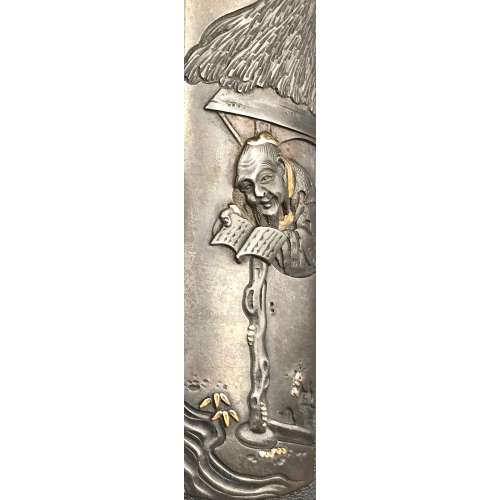 Shibuichi Kozuka carved in low relief (takabori, usuniku-bori) and inlaid in gold and silver with design of Shoko, reading by moonlight, thatch, pine rosettes, and fool moon. According to Henri L. Joly [LEGEND IN JAPANESE ART. London, 1908; LIB-1416 in this collection] Shoko was a Chinese student of Taoism who was so poor that he had no money to buy illuminating materials and read by moonlight. Shoko mentioned in the article about another Chinese character - Shaen, who was reading by the light emitted by glow-worms (see page 310). Signed on the back: Haruchika (春親) + kaō. Size: 97.3 mm (H) x 14.8 mm (W). Edo period, mid 19th century. NBTHK Certificate № 449542. Hamano Haruchika from Edo was a student of Haruyuki in 1848-54; Hamano School, Etchū Toyama Branch, according to M. Sesko's "Genealogy", page. 34. Most probably it is his work. Following the MFA data, it is also possible that "our" Haruchika is indeed Nara Haruchika or Tsuchiya Haruchika from Nara School; though I did not hind such artist in Markus Sesko books. However, in his "Toso-Kinko" on page 177 there is certain Shingorō who carried out his business under the name of Yanagawa Haruchika (1791-1857?)
Shibuichi Kozuka carved in low relief (takabori, usuniku-bori) and inlaid in gold and silver with design of Shoko, reading by moonlight, thatch, pine rosettes, and fool moon. According to Henri L. Joly [LEGEND IN JAPANESE ART. London, 1908; LIB-1416 in this collection] Shoko was a Chinese student of Taoism who was so poor that he had no money to buy illuminating materials and read by moonlight. Shoko mentioned in the article about another Chinese character - Shaen, who was reading by the light emitted by glow-worms (see page 310). Signed on the back: Haruchika (春親) + kaō. Size: 97.3 mm (H) x 14.8 mm (W). Edo period, mid 19th century. NBTHK Certificate № 449542. Hamano Haruchika from Edo was a student of Haruyuki in 1848-54; Hamano School, Etchū Toyama Branch, according to M. Sesko's "Genealogy", page. 34. Most probably it is his work. Following the MFA data, it is also possible that "our" Haruchika is indeed Nara Haruchika or Tsuchiya Haruchika from Nara School; though I did not hind such artist in Markus Sesko books. However, in his "Toso-Kinko" on page 177 there is certain Shingorō who carried out his business under the name of Yanagawa Haruchika (1791-1857?) -
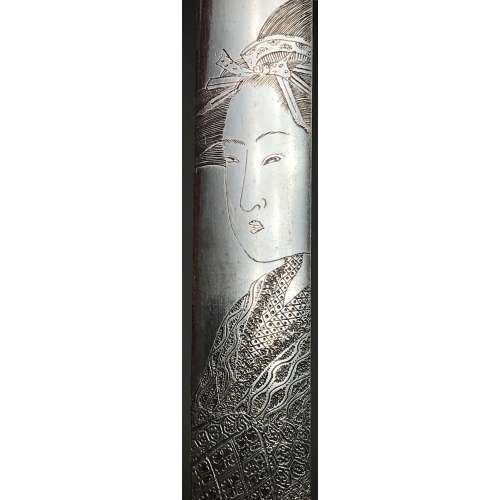 Silver Kozuka carved in kebori ("hair carving") with a ukiyo-e style half-length figure of a beautiful woman (possibly a courtesan) dressed in a splendid kimono and hair ornament (kanzashi). Signed on the back: Koreyasu/Zetai + kaō (是休「花押」) - transcribed by Markus Sesko. Size: 96.8 mm (H) x 14.9 mm (W). Edo period, early 19th century. I managed so far to find the only mention of Koreyasu at Japanese sword-mounts. A descriptive catalogue of the collection of J. C. Hawkshaw, Esq., M.A., of Hollycombe, Liphook. Complied and illustrated by Henri L. Joly. London, 1910 [LIB-1439 in this collection], page 204: 2623. — F./v., nigurome, chased in relief and inlaid with Omori Hikoshichi (large faces). Signed : Koreyasu of Yedo. xix. 2624. — F.K., nigurome, chased and inlaid in relief with Omori Hikoshichi and the witch. Signed : Shinriusha Koreyasu. No pictures of items or signature provided.
Silver Kozuka carved in kebori ("hair carving") with a ukiyo-e style half-length figure of a beautiful woman (possibly a courtesan) dressed in a splendid kimono and hair ornament (kanzashi). Signed on the back: Koreyasu/Zetai + kaō (是休「花押」) - transcribed by Markus Sesko. Size: 96.8 mm (H) x 14.9 mm (W). Edo period, early 19th century. I managed so far to find the only mention of Koreyasu at Japanese sword-mounts. A descriptive catalogue of the collection of J. C. Hawkshaw, Esq., M.A., of Hollycombe, Liphook. Complied and illustrated by Henri L. Joly. London, 1910 [LIB-1439 in this collection], page 204: 2623. — F./v., nigurome, chased in relief and inlaid with Omori Hikoshichi (large faces). Signed : Koreyasu of Yedo. xix. 2624. — F.K., nigurome, chased and inlaid in relief with Omori Hikoshichi and the witch. Signed : Shinriusha Koreyasu. No pictures of items or signature provided. -
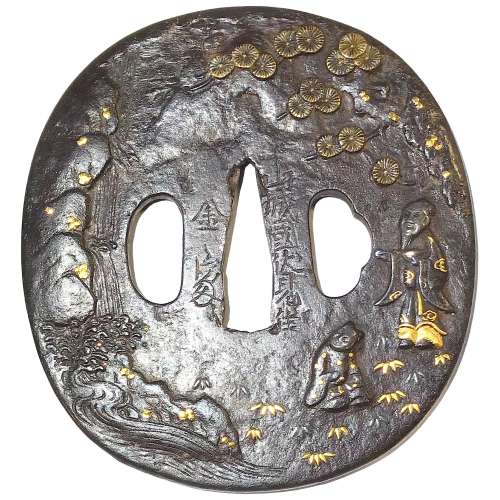
Large oval form tsuba decorated with two human figures (scholar and attendant) under the pine tree admiring a view of a waterfall on the face of the plate, and with stylized dragons carved on the reverse among the symbols of thunder inlaid in gold. The plate is carved in low relief with details inlaid with gold and silver.
Signed: Yamashiro no kuni Fushimi no ju Kaneie [Kaneie of Fushimi in Yamashiro Province] [山城國伏見住金家], with Kaō. It is a fake signature (
gimei). Size: Height: 91.9 mm; Width: 85.6 mm; Thickness: 3.4 mm; Weight: 169 g.
This is a late Edo period, 19th-century export work to cater to the tastes of the European tsuba collectors. It does not have anything in common with the work of great Kaneie masters.
SOLD -
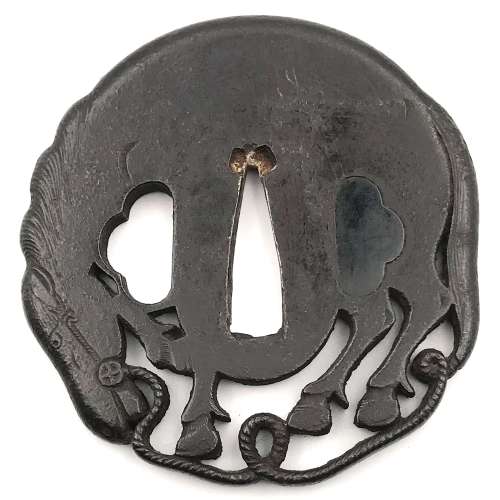
Iron tsuba pierced and carved (marubori-sukashi) with the 'horse in the round' design. Possibly, Bushū-Ito school, 19th century (ca. 1800). Kogai-hitsu-ana plugged with shakudō.
Size: 67.6 x 66.8 x 5.1 mm
Unsigned.
See:
-
- Robert E. Haynes. Study Collection of Japanese Sword Fittings. Nihon Art Publishers, 2010, p. 120: Iron plate carved and formed in the round as a tethered bull...Signed: Bushū jū Sadayasu saku.
- Robert E. Haynes. Masterpiece and highly important tsuba, etc... San Francisco, 1984 // Catalog #9.: Signed: Bushū jū Yoshifusa. Ca. 1800, H 6.7 cm, Th. 4.75 mm.
- The Hartman collection of Japanese metalwork. Christie's, 1976, p. 29, №59: Bushū type, 19th century. Reference to Takezawa, Nihon Toban Zuetsu №411 for a similar design signed Bushū Yoshifusa.
4. Japanese Sword Fittings from the R. B. Caldwell Collection. Sale LN4188 "HIGO". Sotheby's, 30th March 1994, p. 17, №24: An iron tsuba, by Heianjo Sadatsune, Edo period (18th century). In the form of a horse, standing with its head lowered and a rope halter attached to its bit and trailing beneath. Signed Heianjo Sadatsune, 7.3 cm. With NBTHK Tokubetsu kicho paper, dated Showa 49 (1974). GBP 600-700.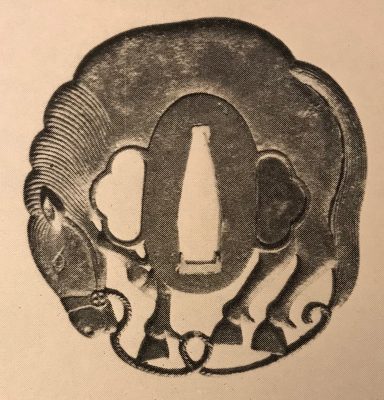
Hartman collection, №59.
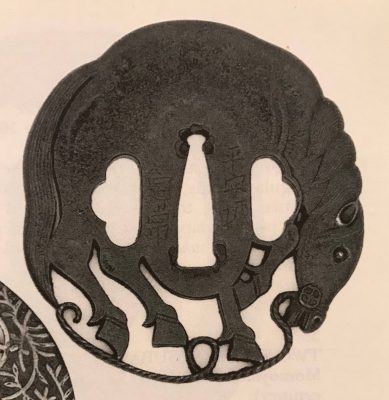
The Caldwell Collection. Heianjo Sadatsune, Edo period (18th century).
-
-
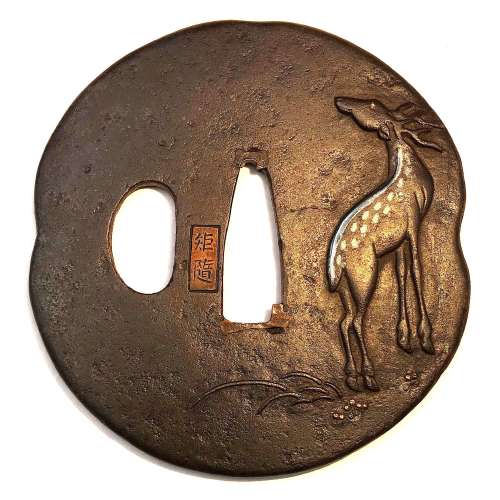 Iron tsuba of ryō-mokko-gata form decorated with a spotted deer (Nara deer or sika deer) motif in low relief carving (sukidashi-bori) and flat silver inlay (hara-zōgan); deer's eyes and details in gold inlay. Signed on a copper cartouche: Noriyuki. Grass in low relief carving on the reverse. There were two Noriyuki in Hamano school - father (Noriyuki I, 1736-1787) and son (Noriyuki II, 1771-1852). Frankly speaking, I don't know which one made this particular piece. Edo period, late 18th or early 19th century.
Iron tsuba of ryō-mokko-gata form decorated with a spotted deer (Nara deer or sika deer) motif in low relief carving (sukidashi-bori) and flat silver inlay (hara-zōgan); deer's eyes and details in gold inlay. Signed on a copper cartouche: Noriyuki. Grass in low relief carving on the reverse. There were two Noriyuki in Hamano school - father (Noriyuki I, 1736-1787) and son (Noriyuki II, 1771-1852). Frankly speaking, I don't know which one made this particular piece. Edo period, late 18th or early 19th century.Size: 71.5 x 70.0 x 3.0 mm.
-
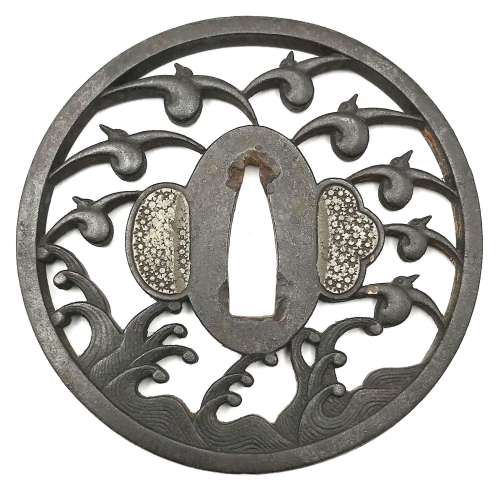
Iron tsuba of circular form with the knotted geese (kari) flying over the rough waves pierced (sukashi) and carved in low relief (nikubori). Hitsu-ana plugged with soft metal. Hitsu-ana plugged with soft metal (tin or lead).
Signed: Echizen koku jū Myochin Katsuharu saku.
Edo period.Size: Height: 80.7 mm; Width: 81.0 mm; Thickness: 4.5 mm; Weight: 110 g.
Two tsuba of this master can be found at Georg Oeder Collection (Japanische Stichblätter und Schwertzieraten. Sammlung Georg Oeder Düsseldorf. Beschreibendes Verzeichnis von P. Vautier. Herausgegeben von Otto Kümmel.Oesterheld & Co / Verlag / Berlin, Oesterheld, 1915; LIB-1465 in this collection) under №№ 172 and 173, page 21, though no illustrations. SOLD. -
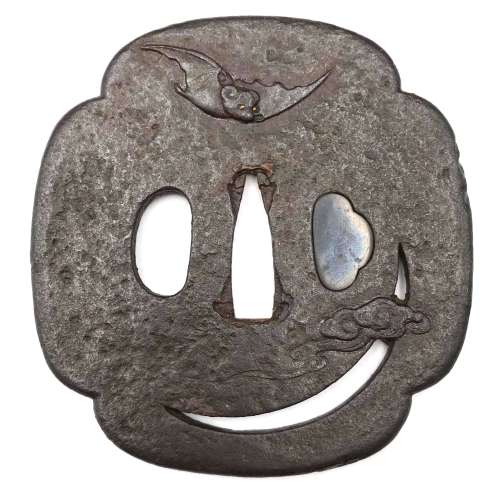
Iron tsuba of mokko form with rough surface decorated in low relief carving (sukidashi-bori) and openwork (sukashi) with a flying bat, a crescent moon, and a cloud over the moon. Bat's eyes inlaid with gold. Crescent moon and cloud on the reverse. Copper sekigane. Kogai hitsu-ana plugged with shakudō.
Unsigned.
Edo period.Size: Height: 83.7 mm; Width: 80.3 mm; Thickness: 2.9 mm; Weight: 141 g.
-
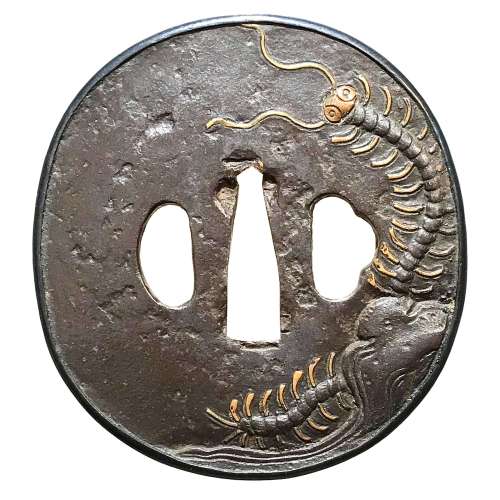
Iron tsuba of oval form with a shakudō fukurin and rough surface decorated by low relief carving and brass inlay with a centipede emerging from under the rock on both sides.
Edo period.Size: 78.9 x 73.6 x 3.8 mm
Unsigned. However, this tsuba may be (though with reservation) attributed to Misumi Kōji school. There is some information regarding this master(s) in Tsuba. An aesthetic study by Kazutaro Torigoye and Robert E. Haynes (from the Tsuba Geijutsu-kō of Kazataro Torigoye. Edited and published by Alan L. Harvie for the Nothern California Japanese Sword Club, 1994-1997) on pages 163-4, though I was not able to locate the tsuba in the original publication. Possibly, this fragment of the book was added by Robert Haynes. Markus Sesko speculates about Misumi in his The Japanese toso-kinko Schools.// Lulu Inc., 2012 on pages 374-5: "Misumi Kōjo Tsuba. Iron plate, elliptical shape, shakudō takabori suemon, yamagane fukurin. Centipede." But of course, visual similarity does not prove anything. I was not able to find any traces of signature or a triangle on the seppa-dai.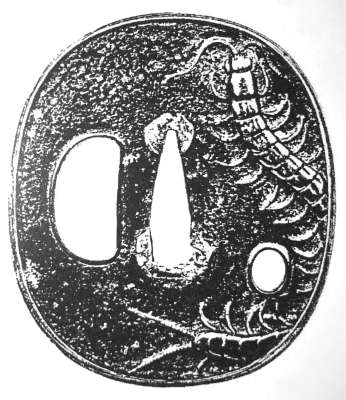
Misumi Kōji Tsuba on p. 163.
-
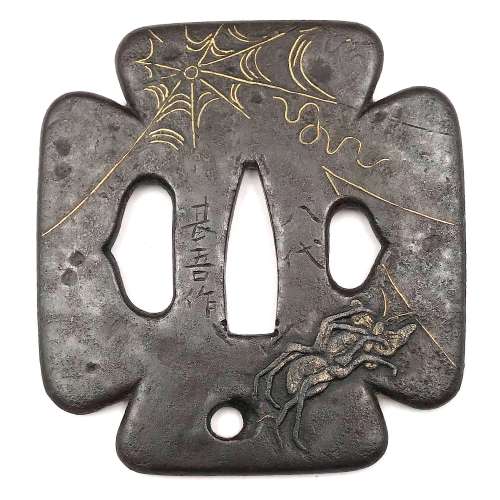
Very fine iron plate well hammered and turned, tapering and rolling to the rounded edge. Tsuba of a cross-form mokko shape (juji-mokko-gata) decorated with spider web inlaid in gold on both sides. The face is carved with a silver-damascened spider holding a gold-damascened butterfly (nunome-zōgan). Kozuka and kogai hitsu-ana of inome (boar's eye) form. The udenuki ana may be of purely decorative purpose.
Signed: Yatsushiro [八代] Jingo Saku [甚吾作], a signature of Chisokutei Amatsune, one of the last Jingo masters.
Late Edo period, Tenpō era, 1830-1844.Size: Height: 77.5 mm; Width: 72.8 mm; Thickness: 4.1 mm; Weight: 141 g.
In a custom wooden box.
Here is what Markus Sesko wrights in his book The Japanese toso-kinko Schools, 2012, on page 374:An artist who worked in the style of the Shimizu-Jingo school was Chisokutei Amatsune (知足亭天常). He was actually a samurai from Yatsushiro who made tsuba as a sideline. An extant old hakogaki of one of his pieces mentions that he died in Edo in the sixth month of An'ei eight (1779) at the age of 73. But the era of An'ei is probably wrong because Chikokutei (sic) is today dated by most experts around Tenpō (1830-1844). His relationships with the Shimizu school or under which Jingo master he had studied are unknown. From the point of view of production time and the finishing of nakago-ana, he is rather associated with the 5th and last gen. Shigenaga who died in the seventh year of Kaei (1854). A peculiarity of Chisokutei was that he signed his Jingo copies with "Yatsushiro Jingo Saku" ([八代甚吾作) but added the small syllable "chi" (チ) or the character "Chi" (知) for "Chisokutei" to identify them as copies.
No longer available. -
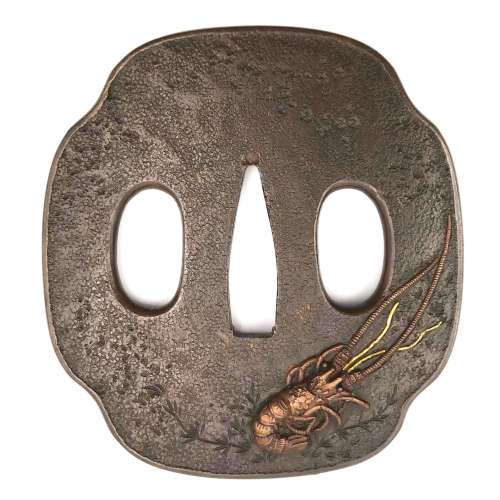
Bronze tsuba of mokkō form with narrow slightly raised rim carved in kebori with the sea weed and inlaid with a lobster (ebi) made of copper on the face and two sea shells made of shakudo on the back. Lobster's antennae inlaid in gold, and eyes inlaid in shakudo. Ishime-ji treated surface.
Unsigned.
Late Edo period (mid-19th century). Dimensions: 76.3 x 71.1 x 3.7 mm -
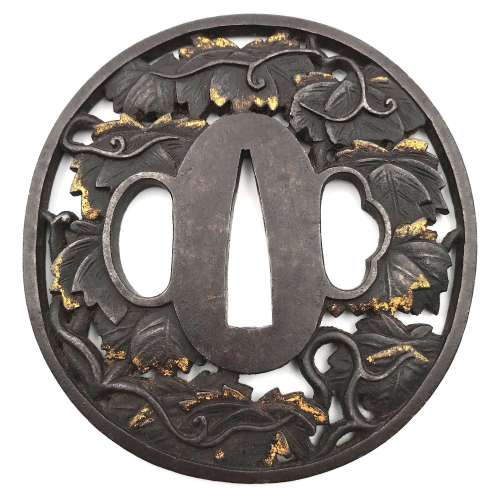
An iron tsuba of slightly vertically elongated circular form carved and pierced with a mass of ivy (tsuta) leaves and tendrils, details damascened with gold in nunome-zōgan technique. Hitsu-ana with raised rim.
Unsigned.
Chōshū school.Height: 72.0 mm; width: 69.0 mm; thickness: 4.7 mm; Weight: 92 g.
According to John W. Dower, "ivy bears fairly close resemblance to both maple leaf and grape leaf". However, I consider this tsuba decorated with ivy leaves for several reasons, such as the lack of racemations in the presence of tendrils. -
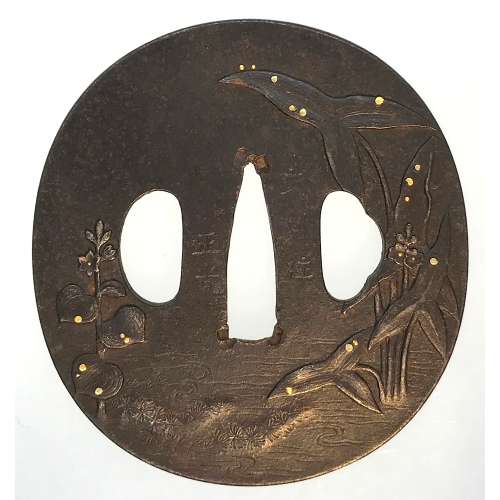
An iron tsuba of oval form decorated with a water plantain (omodaka) carved in low relief and water drops inlaid in gold.
Signed: Bushū jū Masamitsu.
Bushū-Itō school.Height: 71.8; Width: 67.3; Thickness: 3.6; Weight: 96 g.
Mid to late Edo period; 18th-19th century.
There were several tsuba artists with the name of Masamitsu. The one who worked with iron and spelled [正光] is mentioned at Markus Sesko's 'Genealogies' on page 106 in Akasaka School of Edo section as Masamitsu Gorōbei , student of Tadatoki, 4th generation Akasaka master. The name is not mentioned at Torigoye/Haynes 'Tsuba. An Aesthetic Study' in the list of Bushū-Itō family masters on page 181. -
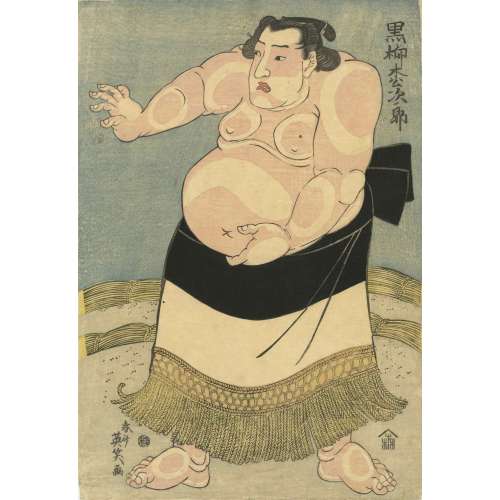 This print was sold to me with the following description: "Ikkansai EISHO (Fl. early 19th c.). A portrait of the wrestler Kuroyanagi Matsujiro, ring name Kumagatake Inosuke. Eisho was a pupil of Eishi. Published c. 1820s by Uoya Eikichi. Signed Shunsai Eisho ga." As a result of our joint effort with my beloved sister, we have so far found the following: The artis is mentioned in The Hotei Encyclopedia of Japanese Woodblock Prints, 2005, Vol 2; p. 438 under the name of Harukawa Eichō. From this source we learned that the artist was active from about 1818 till 1844, and was a print designer in Kyoto. He was a student first of Harukawa Goshichi and later studied in Edo (Tokyo) with Keisai Eisen, when he assumed the art name 'Eichō'. Other names: Shunsai. The Japanese web page dedicated to Harukawa Eichō provides more details: The artist lived from the 4th year of Tenmei ( 1784 ) to the first year of Kaei ( 1848 ). He was a student of Harukawa Goshichi, Kikukawa Eizan as well as of Keisai Eisen. His popular name was Kamenosuke. He was from Kyoto. He took "gagō" (artistic names) of Eishō when he was a student of Harukawa Goshichi; later, when he became a student of Kikukawa Eizan and Keisai Eisen he took the name of Kikukawa Eichō. The artist was mostly known for his bijinga (beautiful women) prints as well as kanazōshi illustrations. Nothing is said anywhere about his sumo prints, though the reference to another Kyushu sumo wrestler portrait has been found. The sumo wrestler Kuroyanagi Matsujiro is also a somewhat obscure figure: information about his life and career is quite inconsistent. It may so happened that two different persons were combined together. Wikipedia page about Aoi Aso Jinja, a Shinto shrine in Hitoyoshi in Kumamoto prefecture, tells us the following:This information has some inconsistencies already. If our hero was born in 1807 and promoted to ōzeki at the age of 32, it should have been the year 1839, not 1847. I found Kumagatake Isuke at "Sumo Reference" website:
This print was sold to me with the following description: "Ikkansai EISHO (Fl. early 19th c.). A portrait of the wrestler Kuroyanagi Matsujiro, ring name Kumagatake Inosuke. Eisho was a pupil of Eishi. Published c. 1820s by Uoya Eikichi. Signed Shunsai Eisho ga." As a result of our joint effort with my beloved sister, we have so far found the following: The artis is mentioned in The Hotei Encyclopedia of Japanese Woodblock Prints, 2005, Vol 2; p. 438 under the name of Harukawa Eichō. From this source we learned that the artist was active from about 1818 till 1844, and was a print designer in Kyoto. He was a student first of Harukawa Goshichi and later studied in Edo (Tokyo) with Keisai Eisen, when he assumed the art name 'Eichō'. Other names: Shunsai. The Japanese web page dedicated to Harukawa Eichō provides more details: The artist lived from the 4th year of Tenmei ( 1784 ) to the first year of Kaei ( 1848 ). He was a student of Harukawa Goshichi, Kikukawa Eizan as well as of Keisai Eisen. His popular name was Kamenosuke. He was from Kyoto. He took "gagō" (artistic names) of Eishō when he was a student of Harukawa Goshichi; later, when he became a student of Kikukawa Eizan and Keisai Eisen he took the name of Kikukawa Eichō. The artist was mostly known for his bijinga (beautiful women) prints as well as kanazōshi illustrations. Nothing is said anywhere about his sumo prints, though the reference to another Kyushu sumo wrestler portrait has been found. The sumo wrestler Kuroyanagi Matsujiro is also a somewhat obscure figure: information about his life and career is quite inconsistent. It may so happened that two different persons were combined together. Wikipedia page about Aoi Aso Jinja, a Shinto shrine in Hitoyoshi in Kumamoto prefecture, tells us the following:This information has some inconsistencies already. If our hero was born in 1807 and promoted to ōzeki at the age of 32, it should have been the year 1839, not 1847. I found Kumagatake Isuke at "Sumo Reference" website:Kuroki Matsujiro (黒木松次郎) was born in the village of Itsuki in Kuma district, Kumamoto prefecture, island of Kyushu in Bunka era, 4th year (1807). Since from his childhood he was blessed by great physique and tough strength. He had affection for sumo. At the age of 18 he became a sumo student of Kumamoto Shimakawa Ikuhei and took the name of Toyama Hidekichi (遠山日出吉). At the age of 23 (1830), he entered sumo stables in Kyoto, mastered the art of taming of young horses, and his talents improved. At the age of 31 he went to Edo, and became a disciple of the ōzeki Oitekaze Kitaro of Hirado domain in Hizen province, also from Kyushu island. After that, he changed his name and became Kuroyanagi Matsujiro (黒柳松次郎 – as on the print). In 1847 (Bunka era, 4th year) he distinguished himself by advancing to the first grade, and at the age of 32 he was promoted to ozeki level, becoming sekitori. After changing his name to Kuma-ga-take Inosuke (熊ヶ嶽猪之介 / くまがたけいのすけ) he displayed further efforts, and became one of the strongmen that fermented sumo wrestling in Edo. In 1853 (Kaei era, 6th year) he retired and returned to his village, becoming an employee as a strongman of Sagara domain (相良藩), and worked hard as instructor of the sumo training hall to train successors until 1855 (Ansei era, 2nd year) when he passed away at the age of 48. Even today Kuma-ga-take's home exists in Itsukimura (his native village). Also, on those grounds a descendant of Kuma-ga-take runs minshuku (guest house) that bears the name of "The Kuroki Pension (lodging) ", and tourists come to visit from various parts of Japan. In 2015, tenth month, within the borders of Aoi Aso Shrine there was built a gravestone publicly honoring Kuma-ga-take Inosuke, sumo wrestler from Edo / of Edo period.
The real name is the same, the ring name Kuroyanagi Matsujiro is the same, however, the date of birth here is 1815. He fought from 1836 till 1853 - which is quite similar to "At the age of 31 he went to Edo, and became a disciple of the ōzeki Oitekaze Kitaro". Though, in 1836 he might be 29 years old. His bouts are listed from spring 1841 to spring 1848 under the name of Kuroyanagi and from winter 1848 till spring 1853 he listed under the name of Kumagatake Isuke [Inosuke].Highest Rank Maegashira 4 Real Name Kuroki Birth Date 1815 Shusshin Kumamoto-ken, Kuma-gun Death Date March 6, 1855 (40 years) Heya Oitekaze Shikona Kuroyanagi Matsujiro - Kumagatake Isuke Hatsu Dohyo 1836.02 (Sandanme) Intai 1853.02 On another important sumo history website, I found that Kuroyanagi first appeared at ring in the spring of 1823 (he might have been 16 years old then, which does not seem right). Then, in the winter tournament of 1848 Kuroyanagi took the name Kumagatake. At the spring tournament of 1853 Kumagatake (Kuroyanagi) retired. This is quite consistent so far.
Then, I found Oitekaze Kitaro, allegedly the teacher of Kuroyanagi.
Everything look good with an exception of ring names (shikona): Kuroyanagi Matsujiro (1823-1828) - Kuroyanagi Sumiemon (1829-30) - Oitekaze Kitaro (1831-1839). May it be that Sato Matsutaro fought under the name of Kuroyanagi Matsujiro until Kuroki Matsujiro took this name from his master? I don't have another explanation of the enigma. What we know is that we have a portrait of a sumo wrestler called Kuroyanagi Matsujiro from Kyushu, but we don't know whether this was the one from Kumamoto (Kumagatake Inosuke, 1807/1815-1855) or the other from Kanagawa (Oitekaze Kitaro, 1799-1865). Subsequently, we may declare that the artist is Shunsai Eishō, a.k.a.Harukawa Eichō from Eishi school (The Hotei Encyclodepdia, p. 524), we can date the print from 1818 to 1844, and only tell that the wrestler is Kuroyanagi Matsujiro from Kyushu (either Kumagatake Inosuke or Oitekaze Kitaro). The publisher of the print is Moriya Jihei (Marks №353, p. 243-5). That's it.Highest Rank Ozeki Real Name SATO Matsujiro (Matsutaro#) Birth Date 1799 Shusshin Kanagawa-ken, Tsukui-gun Death Date May 4, 1865 (66 years) Heya Oitekaze Shikona Kuroyanagi Matsujiro - Kuroyanagi Sumiemon - Oitekaze Kitaro Hatsu Dohyo 1817.10 (Jonokuchi) Intai 1839.03 -
 Richard Parkes Bonington (1802–1828 ). British/French. Evreux: Tour du Gros Horloge (Evreux: Large Clock Tower). Inscription: The tower was built in 1417 when the area was ruled by England. Lithograph. From the Taylor and Nodier set "Normandie", Vol. II, pl. 226. 1824. MET# 22.87.2. Catalogue Raisonné: Curtis 1939, no. 19. MET description: "This view in the French town of Evreux focuses on the clock tower, with vendors and customers in the street below. Bonington produced the print for the multi-volume series directed by Baron Isidore Taylor, Charles Nodier and Alphonse de Cailleux titled "Voyages Pittoresques et Romantiques dans l'Ancienne France" (Picturesque and Romantic Travels through Historic France). This image appears in volume 2, devoted to Normandy."
Richard Parkes Bonington (1802–1828 ). British/French. Evreux: Tour du Gros Horloge (Evreux: Large Clock Tower). Inscription: The tower was built in 1417 when the area was ruled by England. Lithograph. From the Taylor and Nodier set "Normandie", Vol. II, pl. 226. 1824. MET# 22.87.2. Catalogue Raisonné: Curtis 1939, no. 19. MET description: "This view in the French town of Evreux focuses on the clock tower, with vendors and customers in the street below. Bonington produced the print for the multi-volume series directed by Baron Isidore Taylor, Charles Nodier and Alphonse de Cailleux titled "Voyages Pittoresques et Romantiques dans l'Ancienne France" (Picturesque and Romantic Travels through Historic France). This image appears in volume 2, devoted to Normandy." -
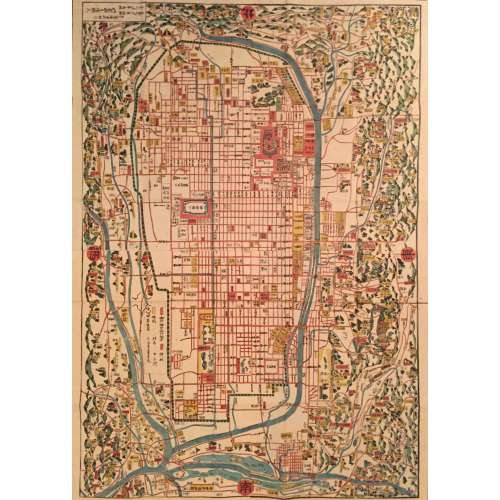
-
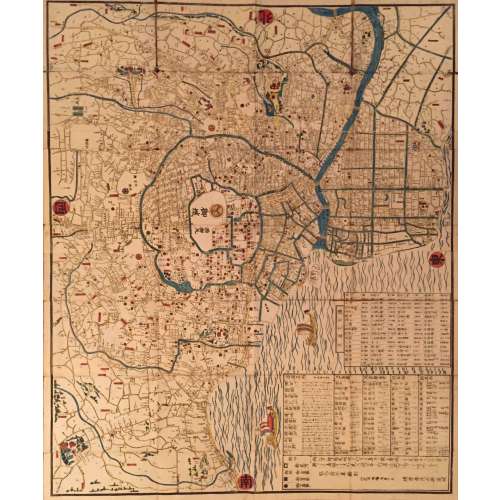
-
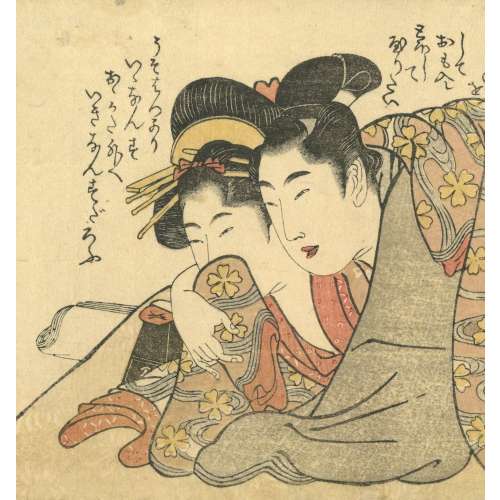 Artist: Kitagawa Utamaro [喜多川 歌麿] (Japanese, c. 1753 – 1806) "This uncommon half-size horizontal ōban ... is most likely one design from a set of twelve prints issued late in Utamaro's life" [Japanese Erotic Fantasies, Hotei Publishing, 2005, p. 143, pl. 47]. Half-size horizontal ōban must be 12.7 x 38 cm. Richard Waldman and Chris Uhlenbeck say it's tanzaku size (13 x 43 cm). In reality, the prints of this series measure 17 x 38 cm, which corresponds exactly to horizontal o-hosoban paper size. I managed to assemble 11 of allegedly 12 designs. 7 of them have genitals colored by hand. It's hard to tell whether it was done by the publisher on demand of a peculiar buyer, or by the owner of the prints who considered the black and white privy parts unnatural. My sequencing of the prints is arbitrary. Transcription of the text may help find the correct order.
Artist: Kitagawa Utamaro [喜多川 歌麿] (Japanese, c. 1753 – 1806) "This uncommon half-size horizontal ōban ... is most likely one design from a set of twelve prints issued late in Utamaro's life" [Japanese Erotic Fantasies, Hotei Publishing, 2005, p. 143, pl. 47]. Half-size horizontal ōban must be 12.7 x 38 cm. Richard Waldman and Chris Uhlenbeck say it's tanzaku size (13 x 43 cm). In reality, the prints of this series measure 17 x 38 cm, which corresponds exactly to horizontal o-hosoban paper size. I managed to assemble 11 of allegedly 12 designs. 7 of them have genitals colored by hand. It's hard to tell whether it was done by the publisher on demand of a peculiar buyer, or by the owner of the prints who considered the black and white privy parts unnatural. My sequencing of the prints is arbitrary. Transcription of the text may help find the correct order.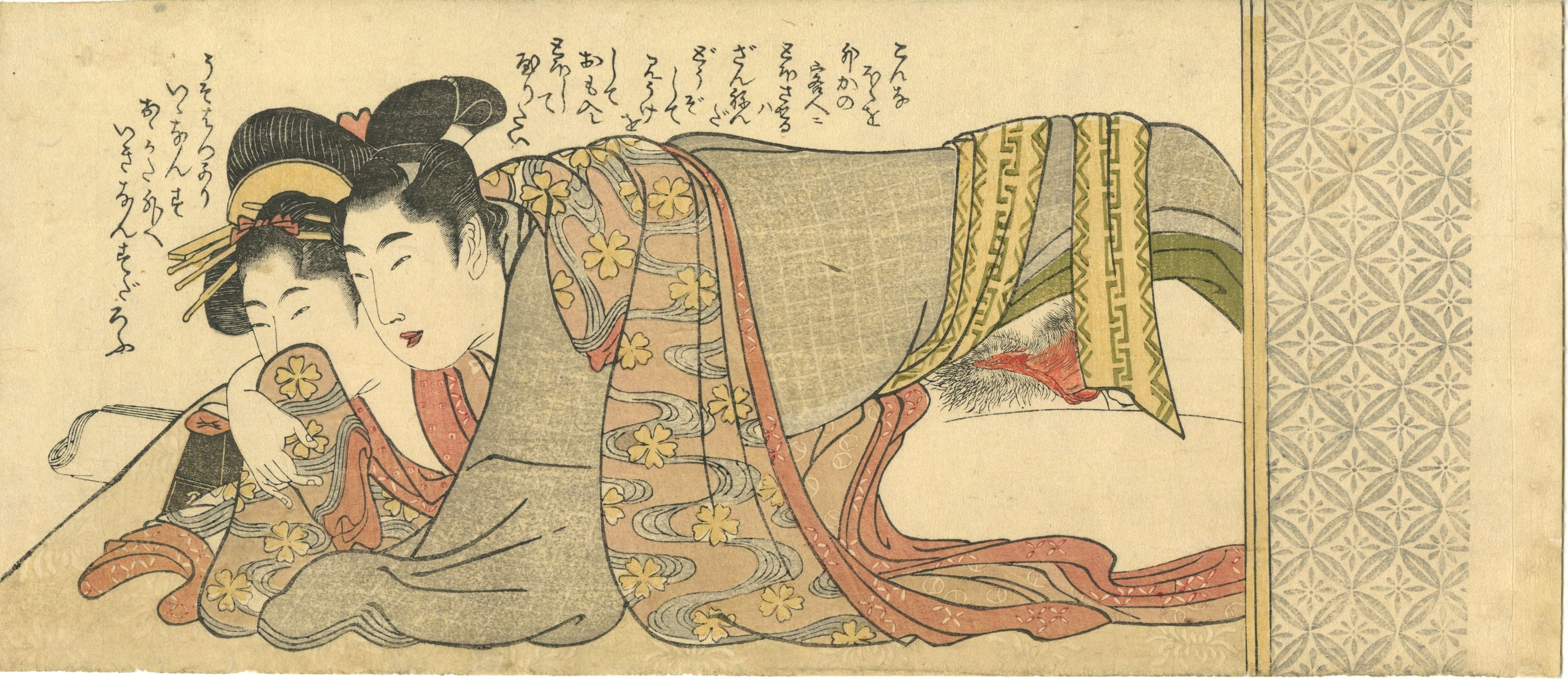 As Japanese Erotic Fantasies put it: "a couple engaged in love-making, their stare fixed outside the picture plane". This is the only image of series that has a reference in available western literature, and the only one found in museum collections: Rijksmuseum Amsterdam (RP-P-1999-2001-16); reference: Fukuda (ed.) (1990), pls. 11-2.
As Japanese Erotic Fantasies put it: "a couple engaged in love-making, their stare fixed outside the picture plane". This is the only image of series that has a reference in available western literature, and the only one found in museum collections: Rijksmuseum Amsterdam (RP-P-1999-2001-16); reference: Fukuda (ed.) (1990), pls. 11-2.
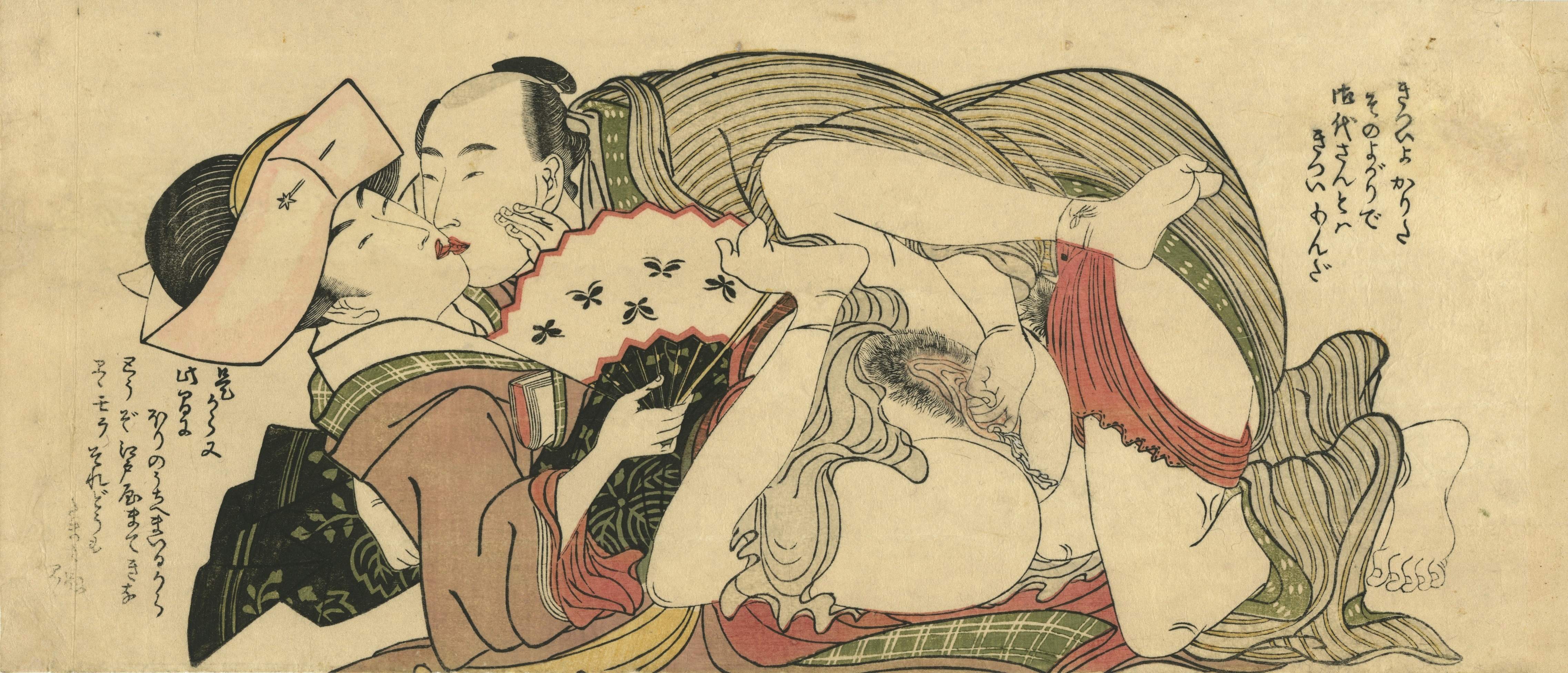 The scene of this print looks quite similar to that of the Kiyonaga's Sode no maki:
The scene of this print looks quite similar to that of the Kiyonaga's Sode no maki:
 The woman is "a young lady-in-waiting of Shogun's Court or Daimyō's Mansion, enjoying a rare outing from her tedious chores" [Richard Lane]. She is fully dressed in her outer cloak (shikake), white paper hat (agebōshi or tsunokakushi), and toed socks (tabi). A book or maybe, onkotogami (roll of tissues known as 'paper for honourable act' ) is still in the folds of her kimono. She is holding an open fan, either to cover her and her lover's faces from an unsolicited witness or to bring some fresh air to their joined lips. The pair just started their sexual intercourse.
The woman is "a young lady-in-waiting of Shogun's Court or Daimyō's Mansion, enjoying a rare outing from her tedious chores" [Richard Lane]. She is fully dressed in her outer cloak (shikake), white paper hat (agebōshi or tsunokakushi), and toed socks (tabi). A book or maybe, onkotogami (roll of tissues known as 'paper for honourable act' ) is still in the folds of her kimono. She is holding an open fan, either to cover her and her lover's faces from an unsolicited witness or to bring some fresh air to their joined lips. The pair just started their sexual intercourse.
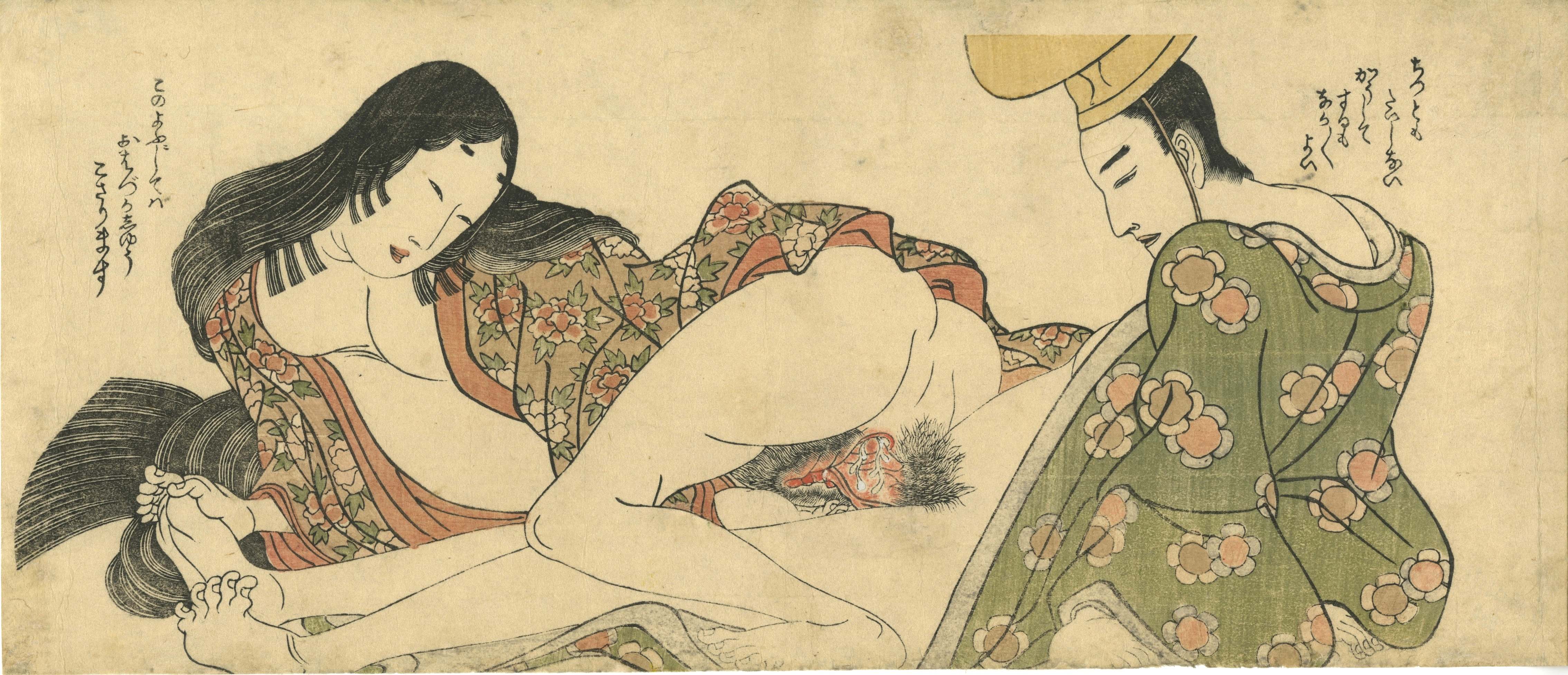 A scene from medieval times. A courtier in eboshi cap having sex with an aristocratic young woman with a long straight hairstyle (suihatsu).
A scene from medieval times. A courtier in eboshi cap having sex with an aristocratic young woman with a long straight hairstyle (suihatsu).
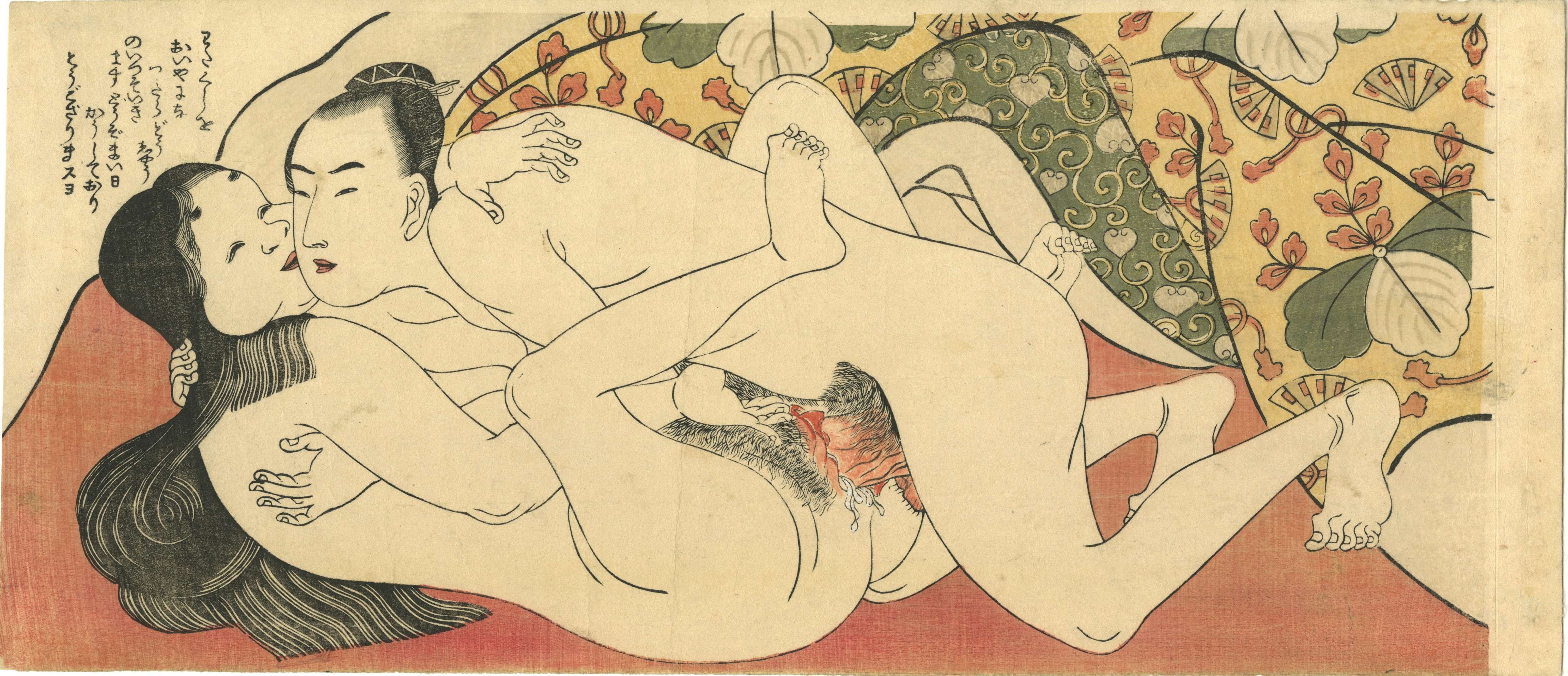 Completely naked couple in the moment of ejaculation. Lavish garments with paulownia leaves on a yellow background counterbalance the white bodies on red bedding. The form of a woman's cheeks is telling, but I don't know about what. Maybe her advanced age?
Completely naked couple in the moment of ejaculation. Lavish garments with paulownia leaves on a yellow background counterbalance the white bodies on red bedding. The form of a woman's cheeks is telling, but I don't know about what. Maybe her advanced age?
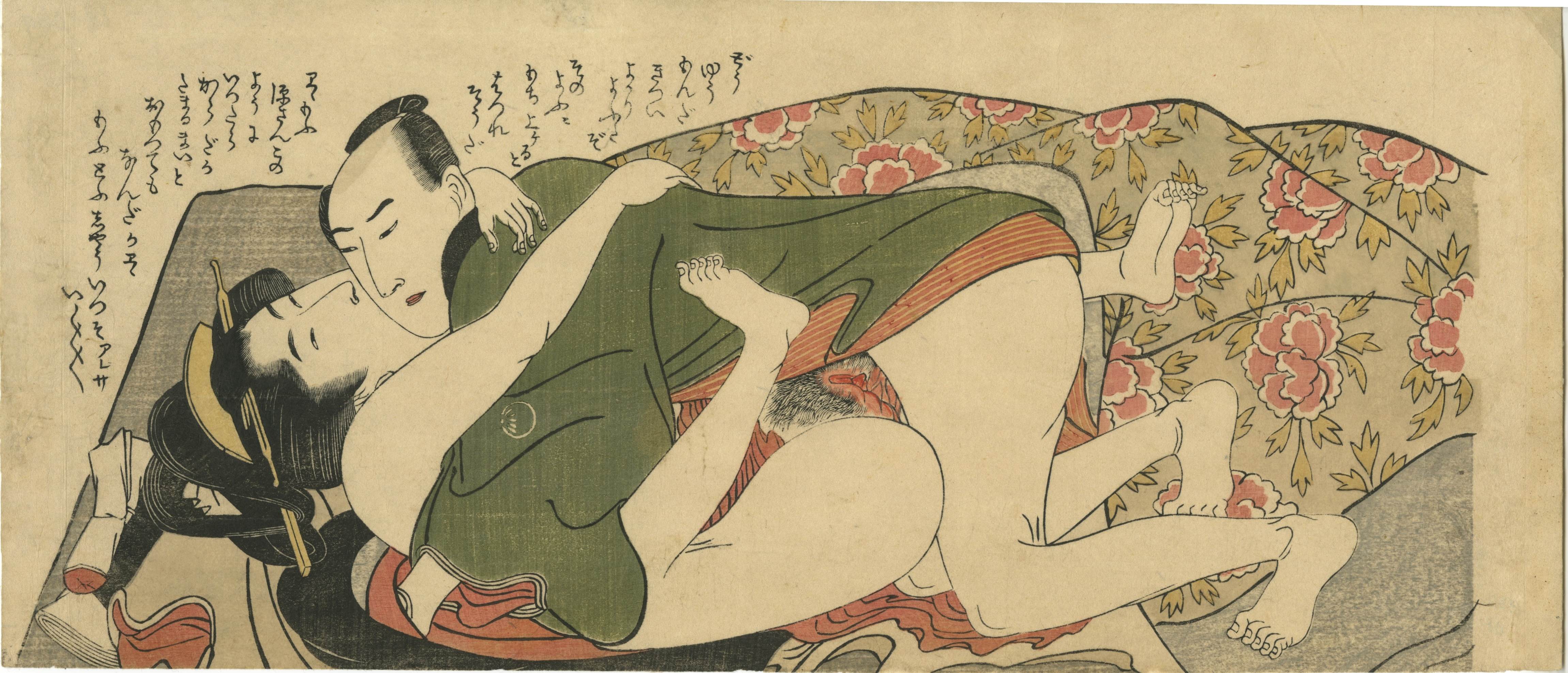 The pose of the couple and the overall composition are similar to that of the previous sheet. Though the lovers are dressed, and the woman's hairdo is well kept. The male looks older and the woman - younger.
The pose of the couple and the overall composition are similar to that of the previous sheet. Though the lovers are dressed, and the woman's hairdo is well kept. The male looks older and the woman - younger.
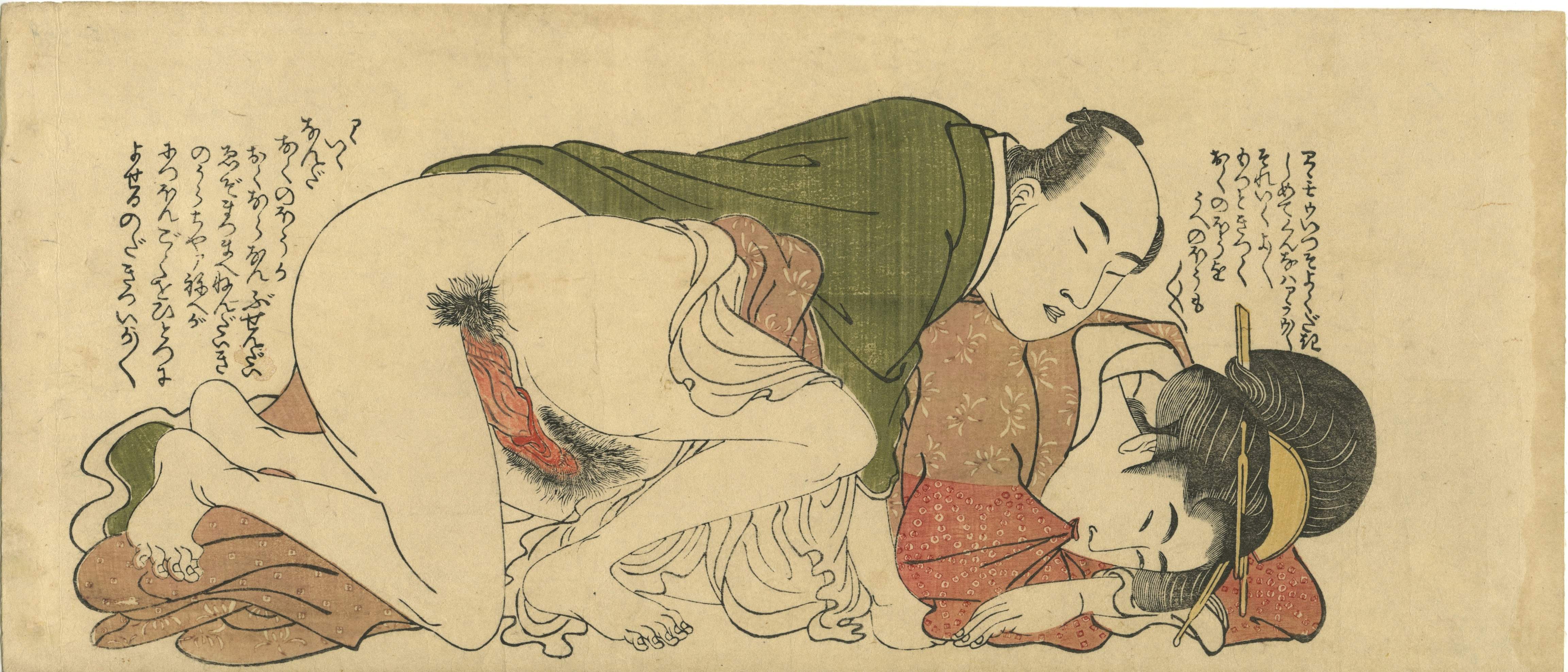 A man takes a young maid from behind. She clenches the sleeve of her kimono in her teeth; it's either the moment of penetration (beginning of intercourse) or of her orgasm (the end of it).
A man takes a young maid from behind. She clenches the sleeve of her kimono in her teeth; it's either the moment of penetration (beginning of intercourse) or of her orgasm (the end of it).
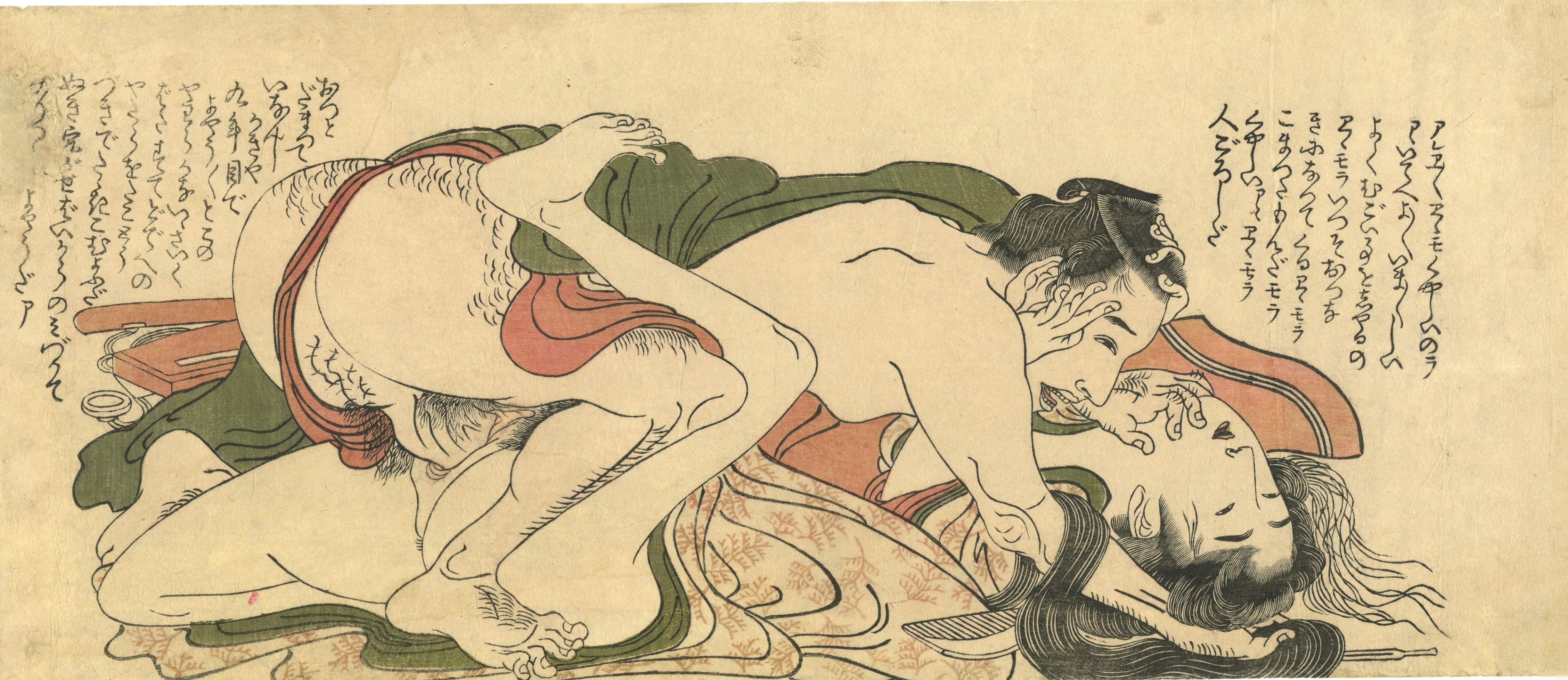 This seems to be a forced intercourse between a lackey with extensive bodily hair and a young maid from the same household.
This seems to be a forced intercourse between a lackey with extensive bodily hair and a young maid from the same household.
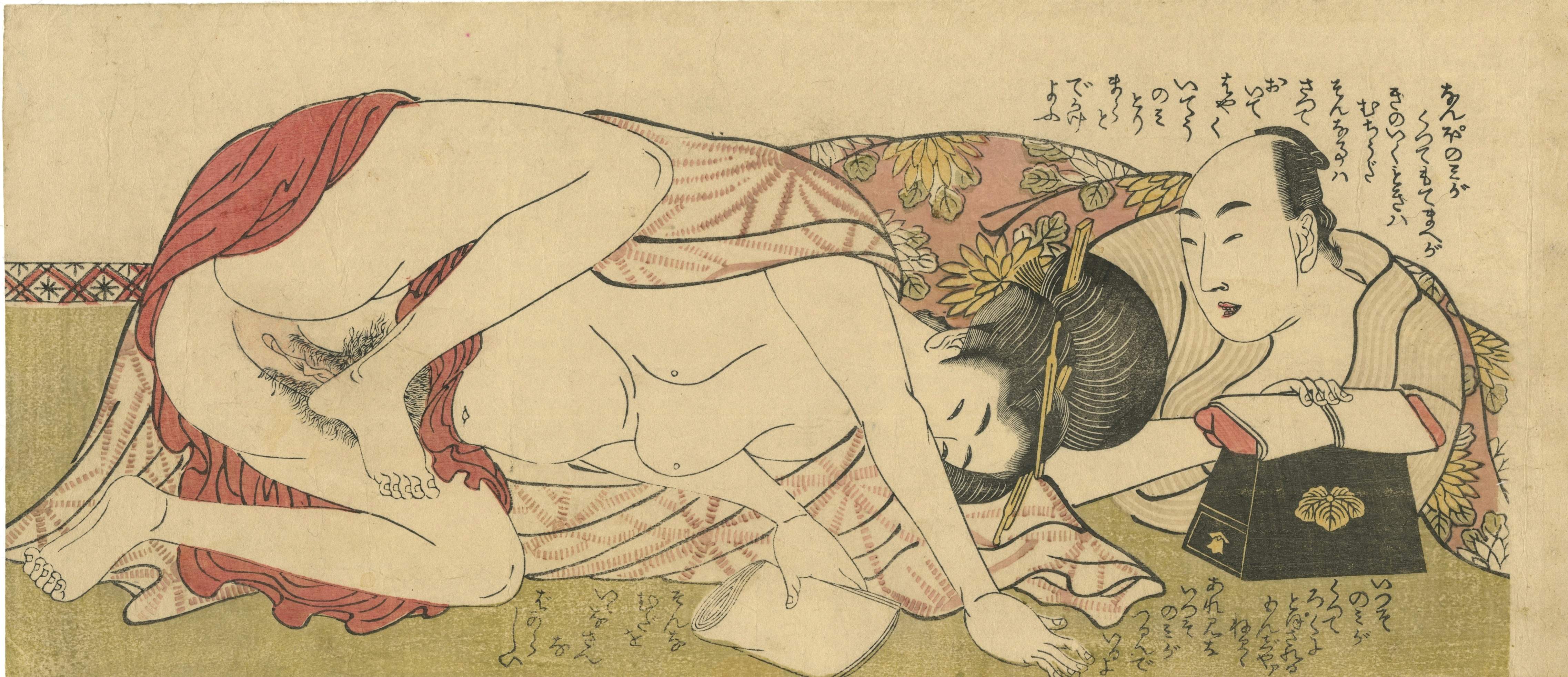 This design is very much like the other one presented below, which is described at Japanese Erotic Fantasies on page 136 (pl. 43b) as follows: "The viewer peers through a mosquito net to see a child fast asleep, while his mother or wet-nurse moves towards her partner. On our print there is no child; instead of a sleeping baby, there is a roll of onkotogami. Fewer objects make the overall image concise, almost laconic in comparison with the Ehon hana fubuki (1802) design:
This design is very much like the other one presented below, which is described at Japanese Erotic Fantasies on page 136 (pl. 43b) as follows: "The viewer peers through a mosquito net to see a child fast asleep, while his mother or wet-nurse moves towards her partner. On our print there is no child; instead of a sleeping baby, there is a roll of onkotogami. Fewer objects make the overall image concise, almost laconic in comparison with the Ehon hana fubuki (1802) design:
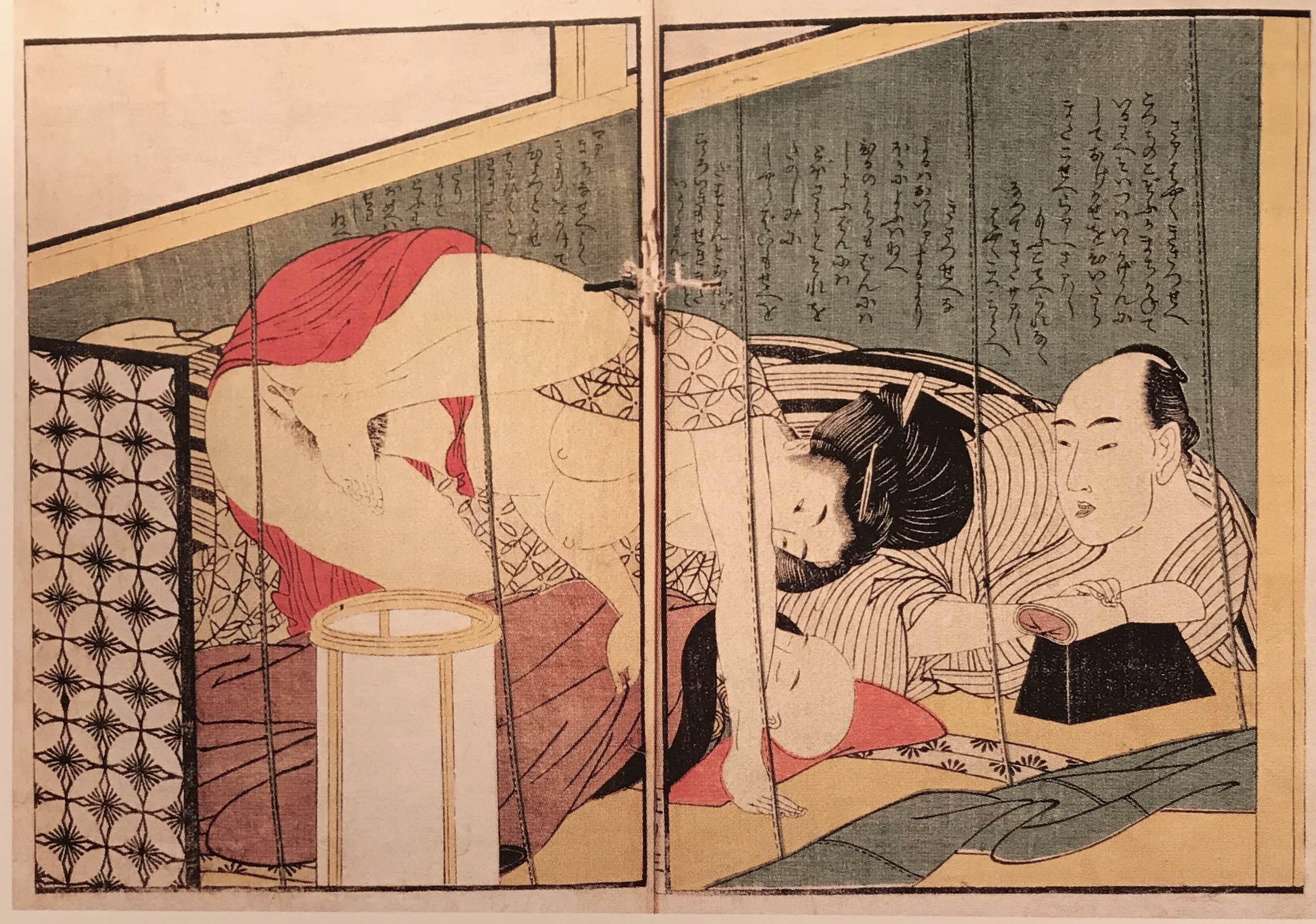
 A young couple in a moment of true love. He is listening to the beating of her heart.
A young couple in a moment of true love. He is listening to the beating of her heart.
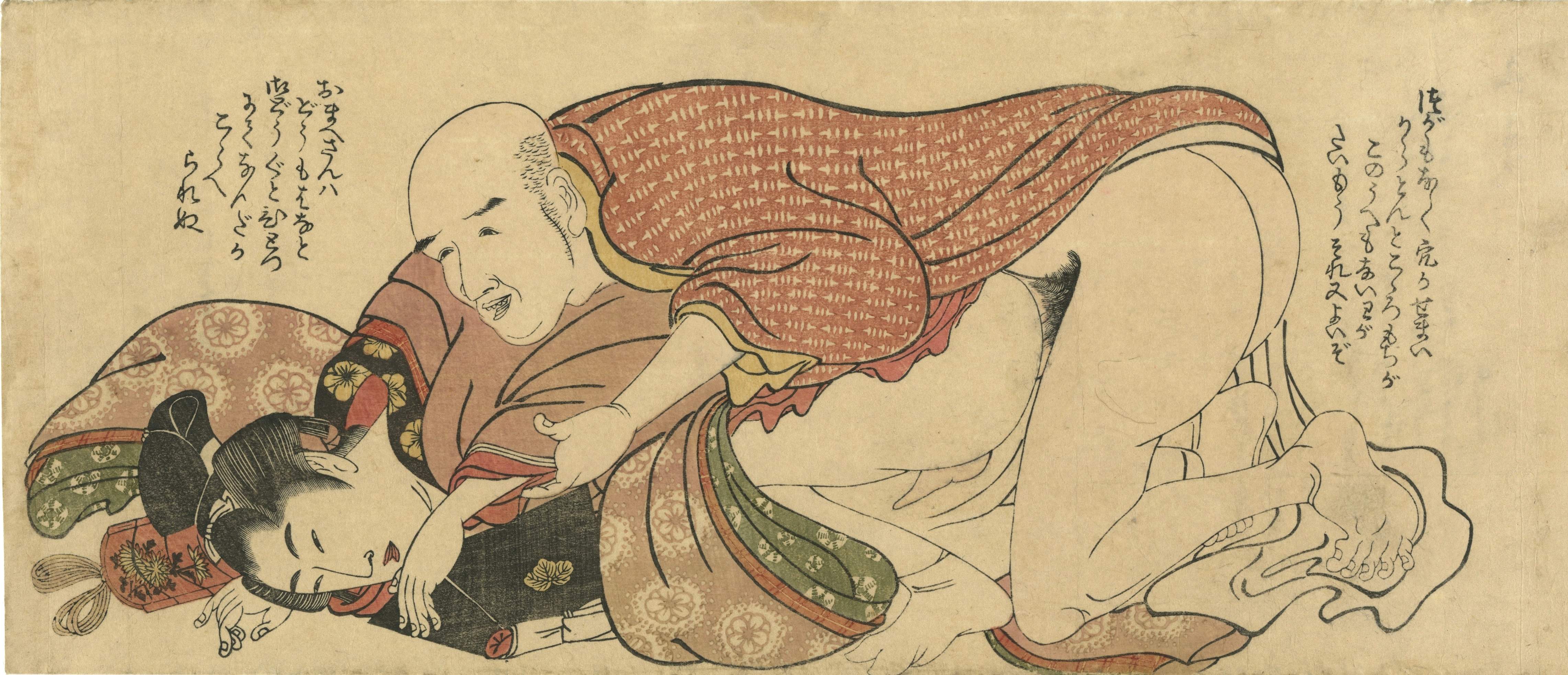 This is a moment of true love between an old monk and a young samurai. The latter even did not take of his socks (tabi).
This is a moment of true love between an old monk and a young samurai. The latter even did not take of his socks (tabi).
 From Japanese Erotic Fantasies: "Boats played a crucial role in the workings of Yoshiwara, as they were the primary means of transport to the district. During the hot summer months, trips on pleasure boats were also a favourite pastime. Sex aboard a boat is a recurrent theme in shunga".
The last print that I am currently lacking and hunting for:
From Japanese Erotic Fantasies: "Boats played a crucial role in the workings of Yoshiwara, as they were the primary means of transport to the district. During the hot summer months, trips on pleasure boats were also a favourite pastime. Sex aboard a boat is a recurrent theme in shunga".
The last print that I am currently lacking and hunting for:
 I know where it is, but I cannot reach it... yet.
I know where it is, but I cannot reach it... yet. -
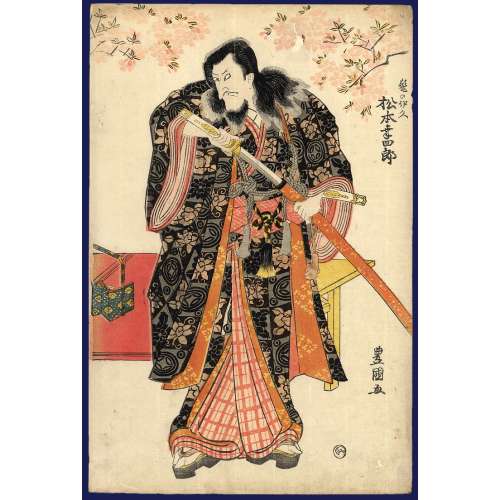 Artist: Utagawa Toyokuni I (1769–1825) Actor Matsumoto Kōshirō V plays the role of Ikyû in the drama "Sukeroku Yukari no Edo Zakura". The roles of Sukeroku and the courtesan Agemaki are played by Ichikawa Danjûrô VII and Iwai Hanshirô V". Ichimura Theater in Edo in 2nd lunar month of 1811. Publisher: Chōjiya Kichi (1811-1826); Marks' "Publishers" № 028, p. 103. Size: Vertical ôban Woodblock print (nishiki-e); ink and color on paper. Signed: Toyokuni ga My print is the right sheet of a triptych (see: Rare books exhibition in January 2013).
Artist: Utagawa Toyokuni I (1769–1825) Actor Matsumoto Kōshirō V plays the role of Ikyû in the drama "Sukeroku Yukari no Edo Zakura". The roles of Sukeroku and the courtesan Agemaki are played by Ichikawa Danjûrô VII and Iwai Hanshirô V". Ichimura Theater in Edo in 2nd lunar month of 1811. Publisher: Chōjiya Kichi (1811-1826); Marks' "Publishers" № 028, p. 103. Size: Vertical ôban Woodblock print (nishiki-e); ink and color on paper. Signed: Toyokuni ga My print is the right sheet of a triptych (see: Rare books exhibition in January 2013). A lookalike triptych by Kunisada can be found in Ronin Gallery:
A lookalike triptych by Kunisada can be found in Ronin Gallery:
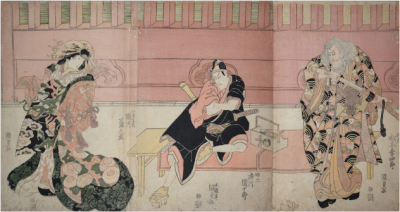 Data from Kabuki21:
Stage names:
Matsumoto Kôshirô V, Ichikawa Komazô III, Ichikawa Sumizô I
Guild: Kôraiya
Line number: GODAIME (V)
Poetry names: Kinshô, Kinkô
Existence: 1764 ~ 10th day of the 5th lunar month of 1838
Connection:
Father: Matsumoto Kôshirô IV
Sons: Matsumoto Kôshirô VI, Ichikawa Sumizô II
Disciples: Matsumoto Kojirô, Matsumoto Kingo I, Matsumoto Hidejûrô II
Data from Kabuki21:
Stage names:
Matsumoto Kôshirô V, Ichikawa Komazô III, Ichikawa Sumizô I
Guild: Kôraiya
Line number: GODAIME (V)
Poetry names: Kinshô, Kinkô
Existence: 1764 ~ 10th day of the 5th lunar month of 1838
Connection:
Father: Matsumoto Kôshirô IV
Sons: Matsumoto Kôshirô VI, Ichikawa Sumizô II
Disciples: Matsumoto Kojirô, Matsumoto Kingo I, Matsumoto Hidejûrô II
Matsumoto Kôshirô V was one of the Kabuki giants, a senryô yakusha, during the Bunka, Bunsei and Tenpô eras. In his 20's he was a tachiyaku actor excelling in nimaime roles like Soga Jûrô Sukenari in sogamono dramas. He started to perform jitsuaku roles from the 11th lunar month of 1798 and quickly became one of the best actors for villain roles, especially in Tsuruya Nanboku IV's kizewamono. He had a considerable influence on actors like Onoe Kikugorô III or Ichikawa Danjûrô VII. The kata he deviced for some of the most famous roles in Kabuki history, like Gonta ("Sushiya") or Nikki Danjô* ("Meiboku Sendai Hagi") are still used nowadays. "The fifth Kôshirô had a very large nose and his eyes were close together, two facial defects the print artists were fond of depicting, so that this Edo actor is easily picked out in the pictures illustrating the theatre of this time." (Zoë Kincaid in "Kabuki, the Popular Stage of Japan")


